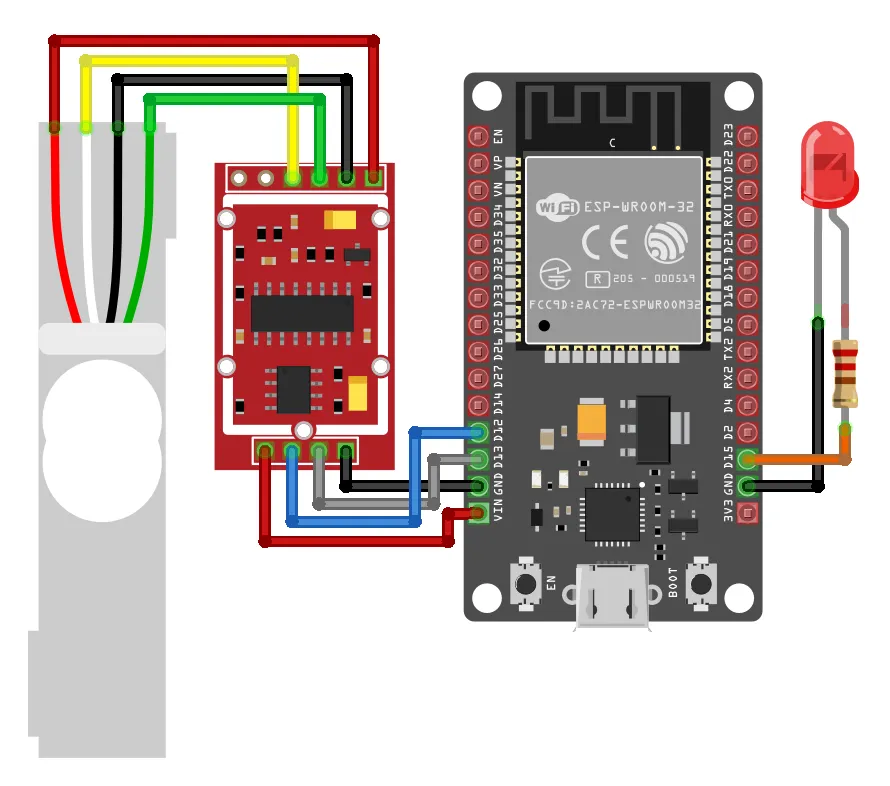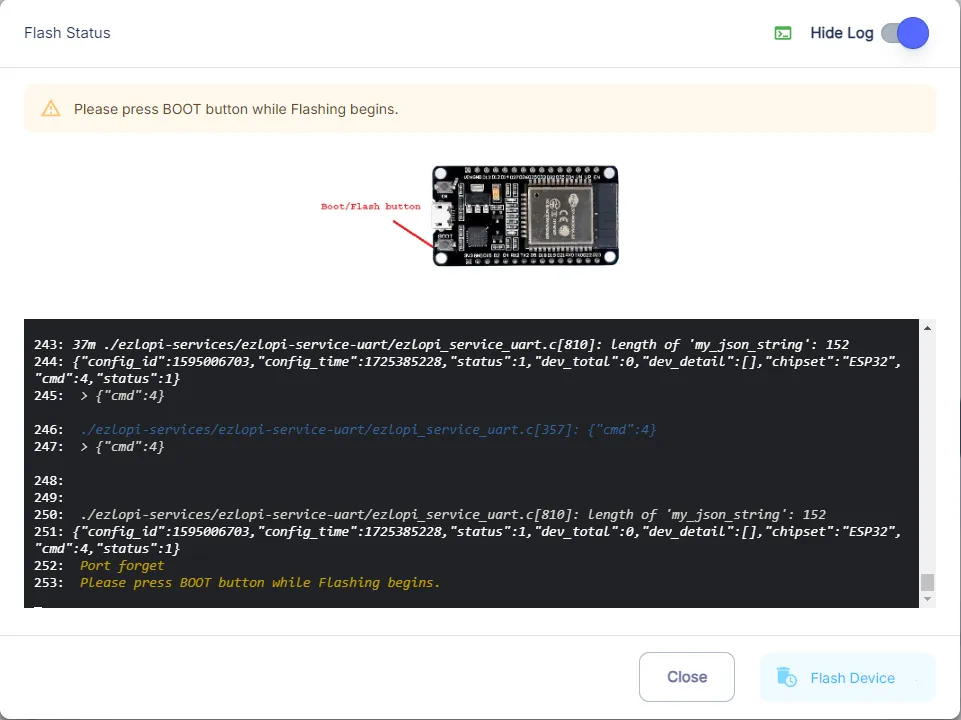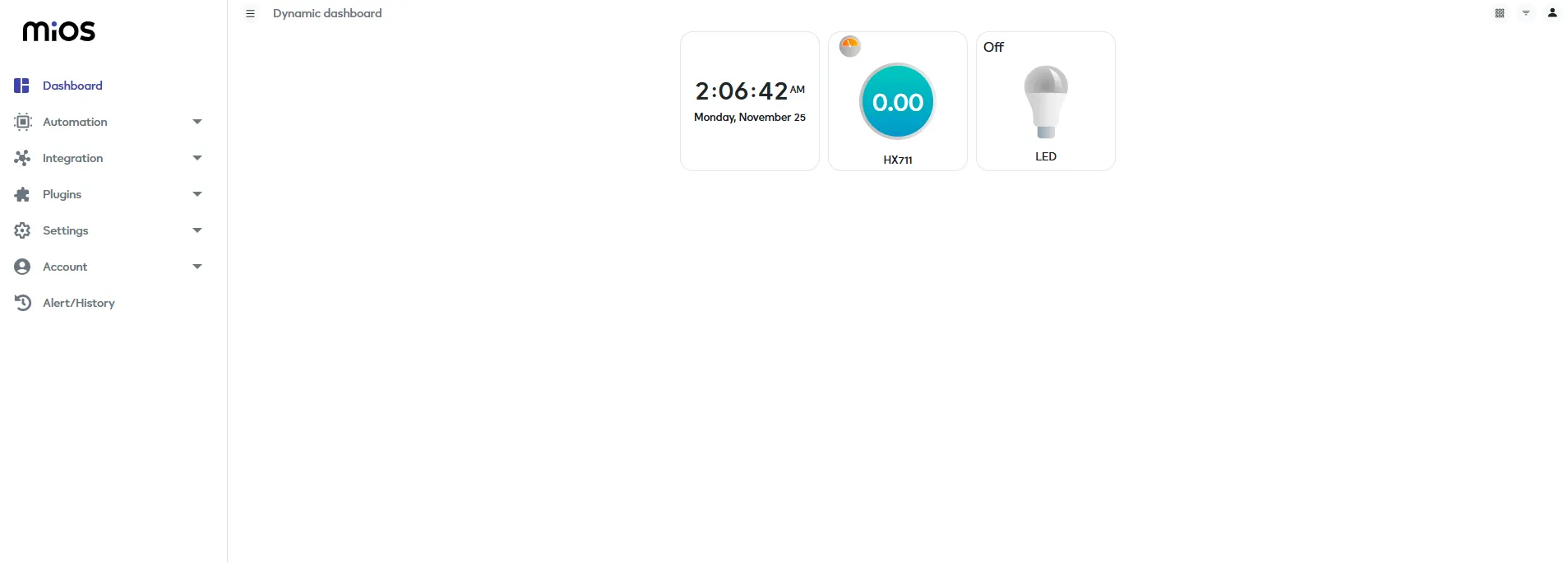
Smart management and convenience!
Smart inventory management system
The EzloPi smart devices provide automation through simple, customizable use with our open-source EzloPi platform, making daily life easier and improving human-machine interactions.
Before moving into this example, it is very important to know about the device registration, provisioning and converting the ESP32 device into an EzloPi device along with knowledge of Web Flasher, MiOS Mobile Application for Android/iOS and the MiOS Web Application.
1. About this example
The smart inventory management system deploys a load cell with an HX711 weight sensor module and an LED, interfaced with the EzloPi device. This system monitors weight changes on inventory shelves to detect the addition or removal of items. When an item is placed or taken, the load cell registers the weight difference, enabling automatic inventory tracking. The LED serves as a status indicator for real-time updates. This setup ensures efficient stock monitoring, reducing manual errors and improving inventory control for businesses or storage solutions.
3. Circuit Diagram & Interface
The following components are required for interfacing with the EzloPi device:
- ESP32 as an EzloPi smart device.
- Load cell with HX711 weight sensor module.
- LED with 120 Ohms Resistor.
The wiring diagram of ESP32 30 pin is represented as follows:


The following connections are made in order to complete the circuit setup.
From ESP32 to the HX711 module:
| ESP32 | HX711 |
| VIN | VCC |
| GND | GND |
| D12 | CK |
| D13 | DO |
From HX711to the Load cell:
| HX711 | Load Cell |
| E+ | Red |
| E- | Black |
| A+ | Green |
| A- | White |
From ESP32 to the LED & Resistor:
| ESP32 | LED | Resistor |
| D15 | - | Terminal 1 |
| - | Anode | Terminal 2 |
| GND | Cathode | - |
4. Interfacing the Load Cell & HX711 Module with EzloPi Web Flasher
1. Set up your device/hardware by visiting config.ezlopi.com

- Log in using the credentials which you just set earlier while signing up.

- Now, click on the Connect Device button and a pop-up window will appear.

- Now, select COM Port to which your ESP32 device is connected. In our case, the COM3 port is used.
Click Connect

- If you are new to this and it's your first time configuring, select Create new Device ID. Enter Wifi SSID and Wifi Password.
- In the Device Configuration, tab click on Other.

- An Other window will be opened for inputting the following parameters:
- Set a Device name of your choosing. In our case, we set it to HX711.
- Set Device Subtype to HX711 LOADCELL.
- Tick mark the GPIO1 and GPIO2 boxes.
- Set the GPIO1 pin to 12.
- Set the GPIO1 pin to 12.
- Then Click Apply Button.
- Again, In the Device Configuration, tab click on Digital Output

- A Digital Output window will be opened for inputting the following parameters:
- Set a Device name of your choosing. In our case, we set it to LED.
- Set Device Subtype to LED.
- Set the OUT GPIO to 15.
- Set the Resistor to PULL UP.
- Then Click Apply Button.
- After clicking the apply button you can see a table of your setting in the device configuration tab.
- Press the Flash Device button.
- A window will appear on the bottom right side of the screen displaying “Please press BOOT button while flashing begins.”

- Hold the BOOT button down until the next window appears on the bottom right side of the screen which says “Installation prepared. Please release the boot button now.”

- Release the BOOT button from your ESP32 when this pop-up on the bottom right window appears.

- After some time, a popup will appear saying Device Flashed Successfully! This means that your device has been set up successfully.
5. MiOS Web Dashboard
- After configuring the controller with the EzloPi web flasher, head to ezlogic.mios.com

- Use the same credential to log in that you used for configuring the controller with the web flasher.

- On the MiOS web dashboard, you will see the tiles of your connected devices as shown above labeled as HX711 and LED. The LED will indicate the conditions according to the output of the load cell which we will set in the meshbot.
MeshBots:

- On the left side of the screen under Automation, click on MeshBots.
- On meshbot screen, click on Create new MeshBot button present on the top right corner of the screen.
- After clicking on Create new MeshBot, you will see this now under Automation MeshBot click on Cloud.

- On the next screen you will see that we can create a name of our choosing, in this case we write it as Test015.

- In the trigger tab you can set the TRIGGER for your device and in the ACTION tab you can set the action to be performed based on the trigger which you have created.

- Set these things in TRIGGER section:
- Set Node Type to Device.
- Set the Node to HX711.
- Set the Capability to parent_abstract.
- Set the Variable to uuid.
- Set the Comparator to Greater (>).
- Set the Value Type to value.
- Set the Value to 4.55.
- Add another device by pressing the Add Trigger button.
- Set Node Type to Device.
- Set the Node to HX711.
- Set the Capability to parent_abstract.
- Set the Variable to uuid.
- Set the Comparator to Less (<).
- Set the Value Type to value.
- Set the Value to 4.45.
- Select the OR condition for both branches from the top left corner.

- Set these values in the ACTION section.
- Set Controllable Type to Device.
- Set Controllable to LED.
- Set the Capability to power_command.
- Set the Value Type to set.
- Set the value to false.
- After clicking the apply button you can see a table of your setting in the Current configuration tab.

- After clicking the save button you can see this screen on the top right corner of the screen.

- Here you can see your saved MeshBot. Now click on Dashboard.

- Now, on the MiOS web dashboard, we can see that when the load cell detects a weight which is more than 4.55kg as per the condition set in the meshbot, then the LED gets turned ON to indicate that some new inventory is added to the inventory shelf.

- Here, we can see that when the load cell gets less weight than 4.45kg which we have set in the meshbot then the LED gets turned ON to indicate that some inventory is taken out of the inventory shelf.
6. MiOS App
You can download the MIOS Android app from the Google Play Store and Apple App Store.
- After downloading the app, proceed to install the application and open it.

- Using the MIOS mobile application, create a new Ezlo Cloud account using the sign-up option. If you already have an account, you may proceed to log in.

- After successfully logging in, you will be able to see the number of controllers connected such as a lamp, fan, or any other device in the MiOS app. Tap on any controller of your desired ID:

- You will be able to see the status of your controller whether it is online or offline. Access the device dashboard, and tap the device. The following view of the dashboard will appear:

- On the MiOS mobile app dashboard, we can see that when the load cell detects a weight which is more than 4.55kg as per the condition set in the meshbot, then the LED gets turned ON to indicate that some new inventory is added to the inventory shelf.

- Here, we can see that when the load cell gets less weight than 4.45kg which we have set in the meshbot then the LED gets turned ON to indicate that some inventory is taken out of the inventory shelf.

eZlopie Products A single-channel 5V relay module $00.00

eZlopie Products Momentary switch $00.00

eZlopie Products Level Shifter Module (BSS138) $00.00

eZlopie Products ESP32
$00.00

eZlopie Products AC Lamp and Holder
$00.00












